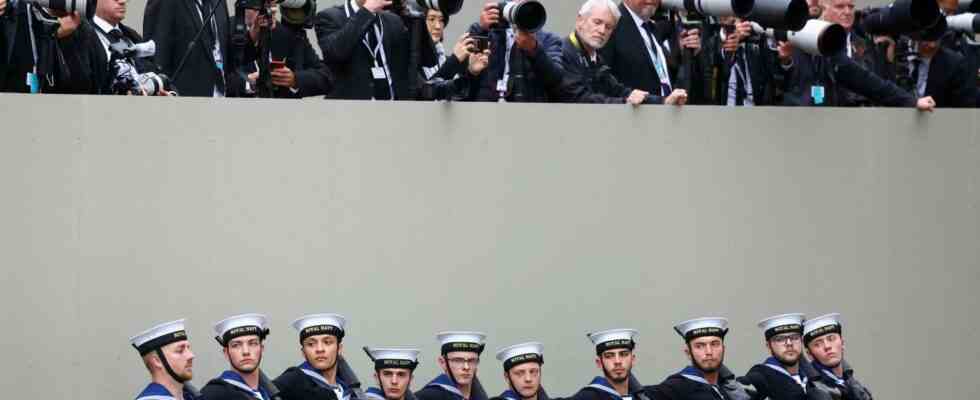TF1, France 2 and the continuous news channels were in special edition, Monday, September 19, sometimes from 5 a.m., to follow the funeral of Queen Elizabeth II: an exceptional device to cover the last episode of a sequence titanic media. This meeting was followed by millions of viewers, according to data from Médiamétrie relayed by Pure Media : 3.36 million on TF1 between 1 p.m. and 1:52 p.m., 3.20 million on France 2 between 1:15 p.m. and 3:15 p.m., 940,000 on BFM-TV between 11:58 a.m. and 1:14 p.m. – the different times correspond to the sequence splittings chosen by each channel.
Since the announcement of the sovereign’s death on September 8, many French media have turned their editorial offer upside down: dozens of reporters dispatched to the United Kingdom, long hours on the air, a daily parade of experts from the royal family, repeated special editions… At the risk of overdoing it?
David Medioni is director of the Media Observatory of the Jean Jaurès Foundation and a journalist. At the beginning of September, he co-wrote and published, in partnership with Arte and the Observatory of Society & Consumption, a report entitled “The French and information fatigue. Changes and tensions in our relationship to information”. He returns to the media coverage of the death of Elizabeth II in a context of overexposure to information.
Even before the announcement of the death of the queen, on September 8, in the early evening, several continuous news channels were already in special edition. For ten days, BFM-TV relocated part of its editorial staff to London and sent a dozen teams there. What does the intensity of the treatment of the death of Elizabeth II reveal?
A distinction should be made between continuous news channels, radio stations, social networks and the written press – even if the latter is not free from reproach, The Parisian having made five “ones” in ten days on the subject. Overall, the breadth of coverage of this event shows an emphasis on emotion rather than information. There was a form of disproportion and a media frenzy in a short-term audience logic. On Sunday September 11, three days after the death of the Queen of England, a major counter-offensive was taking place in Ukraine, and the evening news did not mention it until 8:25 p.m.
In this case as in others, the same vicious circle is set up: social networks are racing [la mort de la souveraine britannique a battu un record historique sur Twitter, le soir de sa mort, avec un pic de 1 834 tweets publiés par seconde] and the media engage, then the politicians react. In this case, the Prime Minister, Elizabeth Borne, went so far as to declare: “The French are also in mourning. » When the media machine kicks in, no one wants to be left out of the big emotional ceremony of the moment.
Given the streaming news channel audiences following the death of Elizabeth II, one would think there is a real demand for these forms of news processing…
I do not believe that. We can have the impression that if the audience is there, then it means that the public follows us. In the study carried out by the Jean Jaurès Foundation, Arte and the Society & Consumption Observatory, and published at the beginning of September, we were able to analyze the immediate effects of the overflow of information on the French: 85% of them say that they often have the feeling of seeing the same news all day; 59% believe that this excess of information prevents them from taking a step back; 53% often feel like they haven’t read or heard anything useful or interesting all day; 51% find it difficult to distinguish what is really important or not; 49% find it difficult to form an opinion…
Even before the continuous news channels, social networks once again provided a very important sounding board for the event. Is it a way to find more personalized information?
What the study we conducted teaches us is that even the most comfortable with social networks do not always manage to navigate the flow of information circulating there. We identified a population that we called the “exhausted hyperconnected” (17% of the sample), mainly young urban graduates with a high media consumption and mastering the codes of social networks, which one would have thought would know how to navigate in this informational universe. In reality, the hyperconnected also report stress and anxiety, linked to this overexposure.
Can we measure the long-term effects of this overexposure to information?
This can lead to forms of media burnout and withdrawal. According to our study, 53% of French people say they regularly deactivate their mobile phone notifications, 30% sometimes force themselves not to turn on the television and 27% say they control the time they spend behind a screen. There is a real desire to withdraw from the media space: 77% of French people questioned say that they sometimes limit their access to information, or even stop consulting it, including 28% regularly.
These audience logics based on emotion are gradually breaking the link between the public and the media. Information overload is squandering both trust and the connection that may exist with viewers, listeners or readers.

